Inside The New York Botanical Garden
Wildlife
Posted in Photography, Wildlife on February 2 2011, by Plant Talk
It’s been a hard winter, and even though Punxsutawney Phil didn’t see his shadow today, we’re with our feathered friends. After this latest winter storm, we’re not quite sure spring is on the way, either. (Even though, let’s be honest, we know it’ll be here before we know it!)
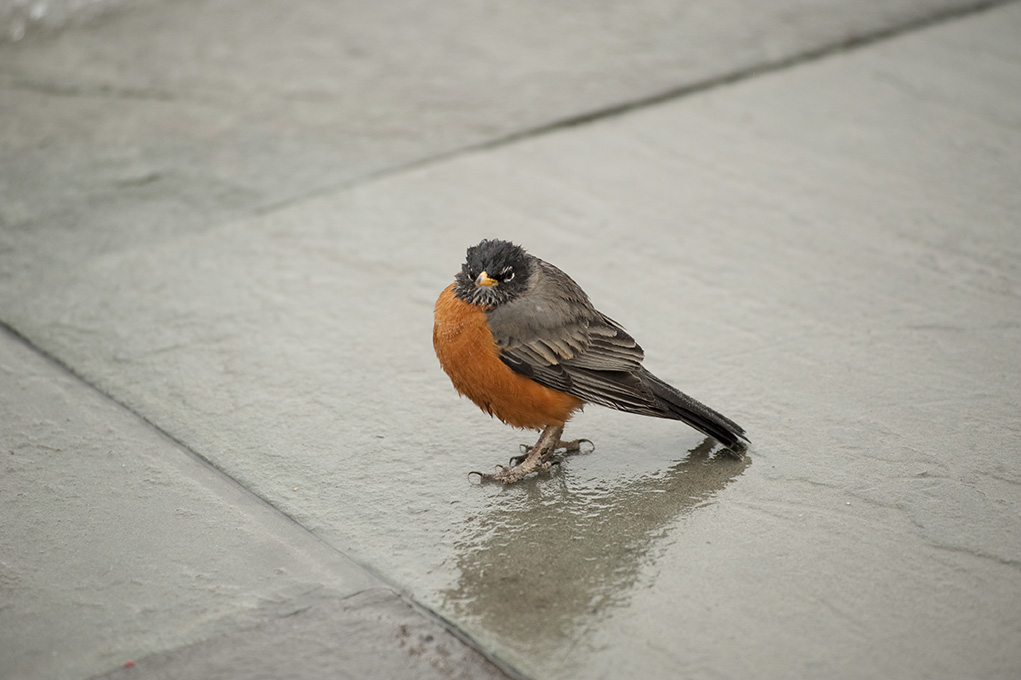
One Obviously Exasperated Robin (photo by Ivo M. Vermeulen)
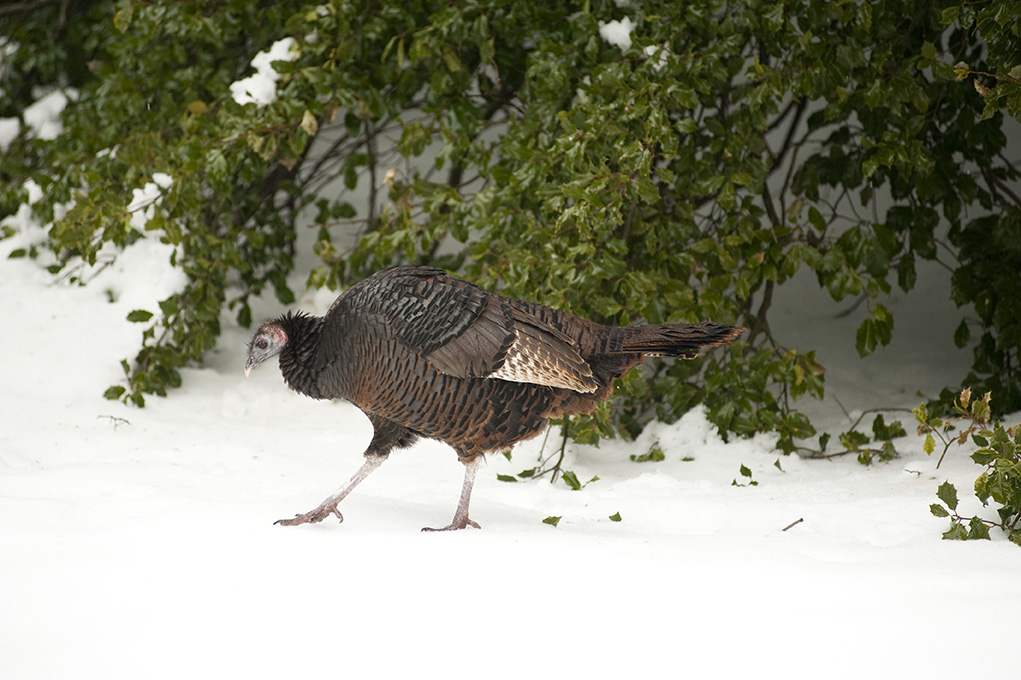
Even the Turkeys Had to be Careful About Where They Walked
(photo by Ivo M. Vermeulen)
Posted in Wildlife on January 25 2011, by Plant Talk
| Chris Nagy is a Ph.D. student at CUNY, and a wildlife biologist at the Mianus River Gorge Preserve in Bedford, N.Y. |
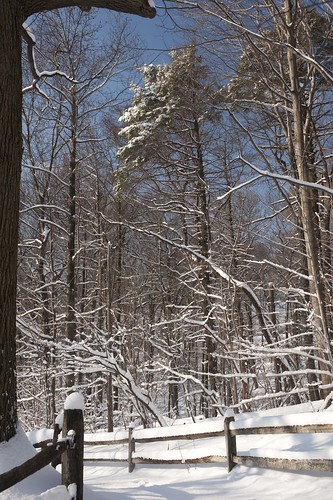 In December I had the opportunity to survey The New York Botanical Garden for Eastern Screech-Owls. I have been chasing Eastern Screech-Owls in the Bronx and Manhattan for nearly 7 years, as part of my Ph.D. research, and getting the chance to look for them in the Garden was a treat.
In December I had the opportunity to survey The New York Botanical Garden for Eastern Screech-Owls. I have been chasing Eastern Screech-Owls in the Bronx and Manhattan for nearly 7 years, as part of my Ph.D. research, and getting the chance to look for them in the Garden was a treat.
The easiest way to look for owls, if you’re willing to wander through the woods at night, is to play recordings of their vocalizations. Most owls communicate primarily through calls, and if there’s an owl nearby, it will probably call back when it hears your broadcast.
There have been no reports of Screech-Owls at the Garden for many years, and we didn’t find any this time either. (Ed. note – Though we have no Eastern Screech-Owls, the Garden is home to at least one Northern Saw-Whet Owl and a family of Great Horned Owls). But determining the places where owls are not is just as important as finding where they are.
By comparing the geographic location, habitat characteristics, and other variables in places where they are found versus where they are not, we can determine what features are important for a species. My hunch is that the absence of Eastern Screech-Owls at the Botanical Garden has more to do with the Garden’s location within the larger city than with any specific habitat quality. Alternatively, there also may be larger raptors at the Garden discouraging the smaller Screech Owls from readily calling back, or from making the Garden their home at all.
I’d like to thank NYBG staff, especially Jessica Arcate Schuler, for their help and allowing me to perform some of my research at the Garden.
Posted in Wildlife on January 13 2011, by Plant Talk
| Mark Weckel is Director of Research and Land Management, Mianus River Gorge Preserve |
From Westchester down to Manhattan, reports of coyote sightings cropped up throughout 2010.
The truth is, coyotes don’t live everywhere (and so far not at The New York Botanical Garden), but they are becoming increasingly more adapted to urban living Researchers from Mianus River Gorge Preserve and WildMetro are using remote cameras (see footage of a coyote at Nature Study Woods in Westchester County below) to monitor urban coyotes to try to figure out one important question: Just how urban can an eastern coyote get?
Coyotes are native to the western U.S., yet have expanded their range throughout the east As of now the only large landmass without a coyote population is Long Island. If coyotes are to colonize Long Island, those living in Westchester and New Jersey will have to go through New York City!
This is giving wildlife biologists the rare opportunity to learn more about how animals adapt to urbanization in real time, which parks and natural areas will support coyotes, how they use man-made and natural corridors, and hopefully, what role these new predators will have to the ecology of the greater NYC metropolitan area.
Video: Nature Study Woods, Westchester County, NY 2010
Posted in Wildlife on January 6 2011, by Plant Talk
| Ann Rafalko is Director of Online Content. |
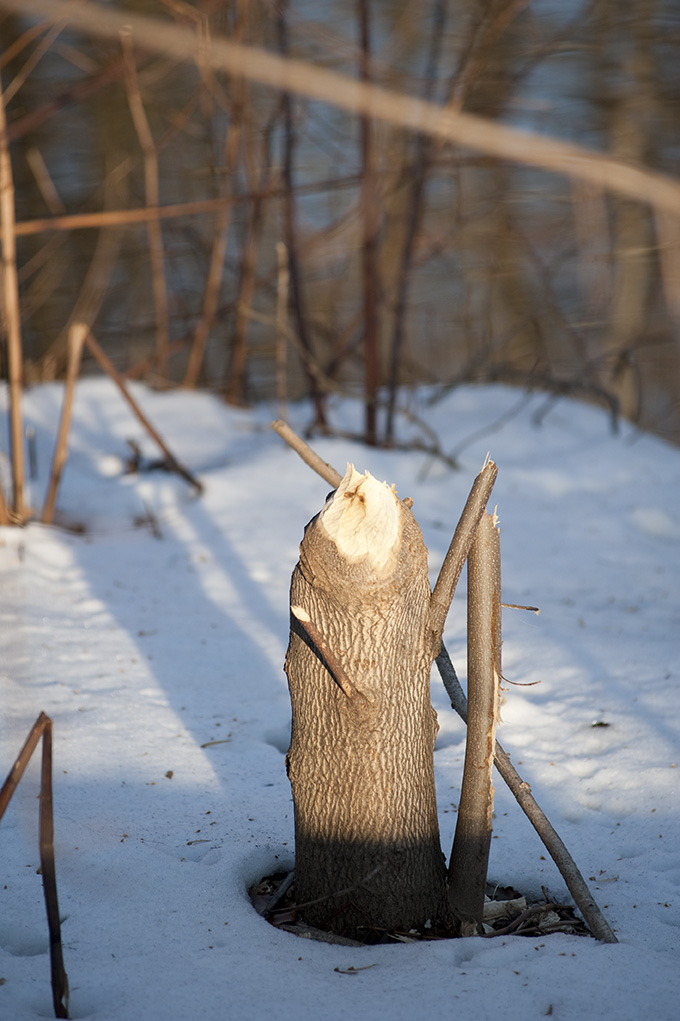 The story of José and Justin Beaver is a tale of two tails.
The story of José and Justin Beaver is a tale of two tails.
In case you’re unfamiliar with the furry duo, perhaps we should offer an introduction. You see, José Beaver is no ordinary beaver. José is, in fact, the first confirmed beaver living within New York City limits in the more than 200 years since his furry forebears were hunted and trapped into local extinction for their luxurious pelts. Beavers were once so important to New York City they are featured on the city’s seal, and frequently act as adornment on buildings around town (and in place names, too).
So, you can see why such a fuss was made when José’s very existence in New York City was confirmed. José is a living link to history. And it only got better when, in October, the existence of José’s pal was confirmed. In a nod to popular culture, he was dubbed Justin Beaver (though, it remains possible that Justin may one day be deemed a Justine–beavers are notoriously hard to sex).
Head below the jump for more on why José and Justin are more than just cute, furry face.
Posted in Wildlife on November 5 2010, by Plant Talk
Owls, Hawks, Sparrows, Even Wild Turkeys, Seen on Free Weekly Walks
 |
Debbie Becker leads a free bird walk at the Garden every Saturday from 11 a.m. to 12:30 p.m., beginning at the Reflecting Pool in the Leon Levy Visitor Center. Photos by Debbie Becker.
|
 Fall arrives with a hint of winter and a longing for summer. The leaves fall and the trees begin to go dormant. For me and other birders, fall signifies transition with the migration of birds. The herons, egrets, and catbirds all leave for warmer climates. Their time in New York City has come to an end, and they flee before winter arrives. But with the fall, too, comes the arrival to New York of the winter birds: juncos, white-throated sparrows, chickadees, titmice, ducks, and owls. Some birders think that winter birding is the best, and it begins in the fall.
Fall arrives with a hint of winter and a longing for summer. The leaves fall and the trees begin to go dormant. For me and other birders, fall signifies transition with the migration of birds. The herons, egrets, and catbirds all leave for warmer climates. Their time in New York City has come to an end, and they flee before winter arrives. But with the fall, too, comes the arrival to New York of the winter birds: juncos, white-throated sparrows, chickadees, titmice, ducks, and owls. Some birders think that winter birding is the best, and it begins in the fall.
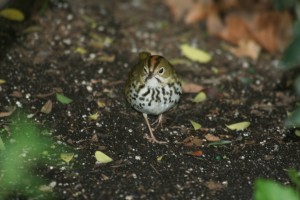 Autumn is sparrow season, and this fall has proven to be a spectacular one at that. So far at NYBG we have spotted field, tree, clay-colored, song, white-crowned, swamp, savannah, chipping, and white-throated (pictured above) sparrows. Along with the flocks of sparrows are yellow-rumped warblers and an assortment of other migrating birds: common yellowthroats, blackpolls, American redstarts, ovenbirds (one pictured at left), black-and-white warblers, black-throated green warblers, black-throated blue warblers, grosbeaks, tanagers, and a variety of vireos and flycatchers.
Autumn is sparrow season, and this fall has proven to be a spectacular one at that. So far at NYBG we have spotted field, tree, clay-colored, song, white-crowned, swamp, savannah, chipping, and white-throated (pictured above) sparrows. Along with the flocks of sparrows are yellow-rumped warblers and an assortment of other migrating birds: common yellowthroats, blackpolls, American redstarts, ovenbirds (one pictured at left), black-and-white warblers, black-throated green warblers, black-throated blue warblers, grosbeaks, tanagers, and a variety of vireos and flycatchers.
We have also spotted overhead at Daffodil Hill migrating turkey vultures, osprey, Cooper’s hawks, sharp-shinned hawks, a kestrel, a rough-winged hawk, and a wonderful merlin that soared in the sunlight, illuminating the copper and red in its wings.
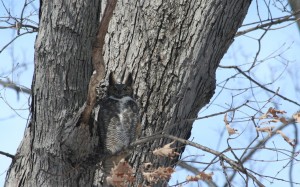 The great horned owls that now inhabit the Forest at NYBG are second generation, as the longtime resident male and female have since died. A junior male (pictured), a possible offspring of the pair, and a new mate have staked their territory. It is amazing to see the junior male roosting in the same spot where the former owls did. He carries on the tradition of hooting in the same Forest area; we look forward to seeing their owlets.
The great horned owls that now inhabit the Forest at NYBG are second generation, as the longtime resident male and female have since died. A junior male (pictured), a possible offspring of the pair, and a new mate have staked their territory. It is amazing to see the junior male roosting in the same spot where the former owls did. He carries on the tradition of hooting in the same Forest area; we look forward to seeing their owlets.
Yellow-bellied sapsuckers, a name that always elicits a laugh, are plentiful at the Garden as are other woodpeckers: hairy, downy, and a persistent red-bellied that can be observed by Twin Lakes. It flies back and forth, grabbing acorns from an oak and depositing them in an open knot in a tree, storing them for winter.
Chickadees and titmice have arrived in record numbers. Recently we watched a brown thrasher by the crabapples wandering up the road as a hermit thrush and eastern phoebe looked on. Cedar waxwings and robins that will spend the winter at the Garden were eating berries from a polycarpa tree. Grackles, which migrate in the thousands, have begun lighting on nearby lawns.
Before you start thinking about Thanksgiving, come see the two wild turkeys that are regularly seen behind Shop in the Garden. They peck and scrape the gravel and grass looking for morsels to feed on.
I look forward to cool days with misty air—and birds that delight us. Come join us on a walk.
Posted in Wildlife on September 29 2010, by Plant Talk
 |
Linda R. Cox is Executive Director of the Bronx River Alliance and Bronx River Administrator for the New York City Department of Parks & Recreation. Photos: Steve Zack for the Bronx River Alliance. |
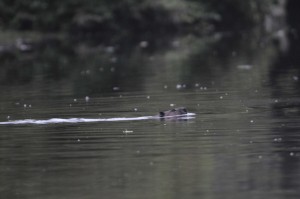 On an overcast evening last month, five canoes set off on the cool, still waters of the Bronx River amid the shaded forests of the Bronx Zoo and The New York Botanical Garden. We were four Bronx River Alliance staff and seven intrepid adventurers, all on the search for José the Beaver.
On an overcast evening last month, five canoes set off on the cool, still waters of the Bronx River amid the shaded forests of the Bronx Zoo and The New York Botanical Garden. We were four Bronx River Alliance staff and seven intrepid adventurers, all on the search for José the Beaver.
José, named in honor of Congressman José E. Serrano for his unstinting support of the Bronx River’s revitalization, has lived on the Bronx River since 2006. Nonetheless, he is seldom seen. Even Josue Garcia and Miguel Rodriguez, who led hundreds of paddlers down the river this summer, had not seen him. But this time we had chosen José’s favorite hour for activity—dusk. Our hopes were high. Five wildlife biologists were with us to help witness José’s life on the river.
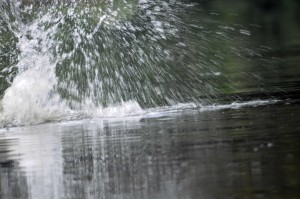 We paddled upstream, passing under Fordham Road into the Botanical Garden, and there he was, floating in the water under a willow tree. With the top of his head and back visible, José swam away from the tree, gave two mighty thwacks with his tail, and dived under the water, suddenly gone, invisible.
We paddled upstream, passing under Fordham Road into the Botanical Garden, and there he was, floating in the water under a willow tree. With the top of his head and back visible, José swam away from the tree, gave two mighty thwacks with his tail, and dived under the water, suddenly gone, invisible.
Read More
Posted in Wildlife on September 22 2010, by Plant Talk
Butterflies Migrate Through the Garden on Way to Mexico
 |
 |
Dorrie Rosen and Anita Finkle-Guerrero are Plant Information Specialists at The New York Botanical Garden. |
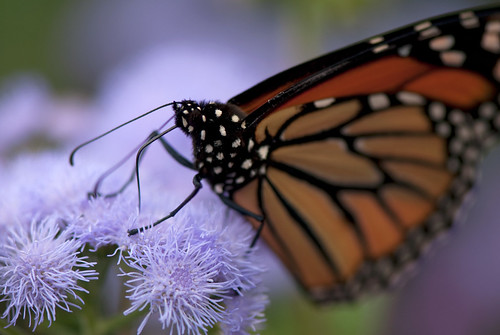 The annual celebrated journey of monarch butterflies is now under way. Perhaps you’ve already seen individual monarchs floating past as they head south to their winter home in Mexico on one of the most unique migrations in the natural world—a round-trip that spans three or four generations of monarchs. Each fall these beautiful black-and-orange creatures migrate to a relatively small geographic area in central Mexico where they huddle in masses on trees to conserve heat and be protected from buffeting winds and rains.
The annual celebrated journey of monarch butterflies is now under way. Perhaps you’ve already seen individual monarchs floating past as they head south to their winter home in Mexico on one of the most unique migrations in the natural world—a round-trip that spans three or four generations of monarchs. Each fall these beautiful black-and-orange creatures migrate to a relatively small geographic area in central Mexico where they huddle in masses on trees to conserve heat and be protected from buffeting winds and rains.
Severe weather in Mexico last winter—drought, wind, and mudslides, which took down trees—as well as continual illegal logging, land development, and pesticide use have negatively impacted the monarch population.
Home gardeners can help monarchs by creating conditions necessary for their survival throughout their life cycle: providing food (planting their favorite plants), water, and shelter for both larval and adult stages.
To view some of the plants at the Botanical Garden that the monarch feeds on, visit the Home Gardening Center, the Everett Children’s Adventure Garden, the Jane Watson Irwin Perennial Garden, and other living collections within our 250-acre landscape. Milkweed is the preferred host plant for monarch caterpillars and can be seen in the Children’s Adventure Garden. Also look there for other butterfly favorites: goldenrod, Joe-pye weed, and sedum. We saw monarchs on butterfly bush, lantana, sedum, and zinnia in the Home Gardening Center.
Posted in Learning Experiences, Wildlife on September 15 2010, by Plant Talk
Learn About This Popular Urban Hobby in Dig in! Adult Ed Course
 |
Sara Katz is the Community Horticulturist for Bronx Green-Up, the community outreach program of The New York Botanical Garden, and a hobbyist Bronx beekeeper. She will teach Beekeeping Basics at the Midtown Education Center. |
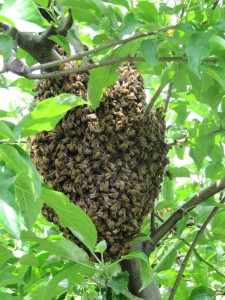 Beekeeping is proving itself an urban hobby, with hives popping up on rooftops, in backyards, and in community gardens throughout New York City. Even the Botanical Garden has two hives in the Ruth Rea Howell Family Garden.
Beekeeping is proving itself an urban hobby, with hives popping up on rooftops, in backyards, and in community gardens throughout New York City. Even the Botanical Garden has two hives in the Ruth Rea Howell Family Garden.
As a Bronx beekeeper myself, I regularly marvel at the detailed work of the colony: the bright colors of pollen brought back from so many flights, the hoarded honey, and the careful nursing of new life in the brood chamber.
The urban honeybee has faired well this summer, with ample sunshine, and in turn, abundant blooms of plants such as mountain mint (Pycnanthemum virginianum). The leaves of this native perennial make a good tea or can be applied as mosquito repellant. Butterfly bush (Buddlea davidii), a shrub that can tolerate urban pollution and alkaline soils, has tufts of tiny purple flowers on show for months—a perfect plant for pollinators. These and many other flowering plants, from vegetables and herbs to street trees, are visited by bees and other pollinators in great numbers every season.
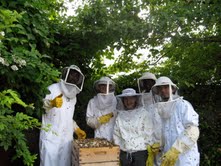 One Bronx beekeeper who keeps hives behind a rectory abutting the Genesis Park Community Garden has harvested 275 pounds of honey since July. It tastes floral, minty, and may originate in good part from the nectar of white clover, a spring bloomer found on lawns and other open spaces in the city.
One Bronx beekeeper who keeps hives behind a rectory abutting the Genesis Park Community Garden has harvested 275 pounds of honey since July. It tastes floral, minty, and may originate in good part from the nectar of white clover, a spring bloomer found on lawns and other open spaces in the city.
Read More
Posted in People, Wildlife on September 1 2010, by Plant Talk
It’s Been a Hoot for Debbie Becker, Who Launches New Season on Saturday
 |
 |
Carol Capobianco is Editorial Content Manager at The New York Botanical Garden, and Nick Leshi is Associate Director of Public Relations and Electronic Media.
|
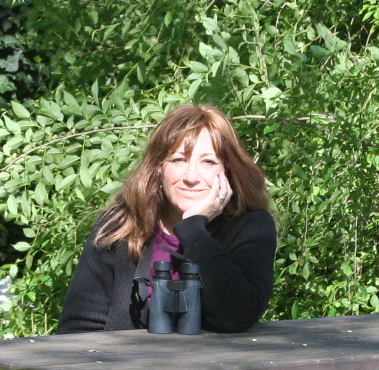 Every Saturday at 11 a.m. throughout most of the year, a few dozen people gather at the Reflecting Pool in the Leon Levy Visitor Center with binoculars and high hopes. They’ve come to go on a walk in search of the birds that live at the Botanical Garden either year-round or temporarily during migration periods.
Every Saturday at 11 a.m. throughout most of the year, a few dozen people gather at the Reflecting Pool in the Leon Levy Visitor Center with binoculars and high hopes. They’ve come to go on a walk in search of the birds that live at the Botanical Garden either year-round or temporarily during migration periods.
The tour leader, Debbie Becker, who this season marks her 25th year conducting bird walks at the Garden, knows all the nooks and crannies, and all the favorite spots of many of the nearly 200 species that have been recorded in the Garden over the years. In other words, if someone wants to see a particular bird—say, the resident great horned owls or the aberrant white-winged crossbills—Debbie can deliver.
“The habitat dictates what kind of bird you’re going to see,” explains Debbie. “And in the Garden’s 250 acres of diversified habitat, you can see a lot of birds. You can walk from a forest, to a meadow, river, waterfall, ornamental garden, and native plant garden in just a couple of hours.”
Read More
Posted in Learning Experiences, Wildlife on August 19 2010, by Plant Talk
See Honey Taken from Hive Saturday as Part of National Celebration
 |
Toby Adams is Manager of the Ruth Rea Howell Family Garden. |
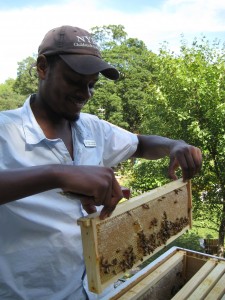 Every day during the gardening season, the Family Garden is a hive of activity hours before visitors arrive. A diverse staff—coordinators, instructors, explainers, volunteers, and interns—zip about this way and that, preparing for the day’s programs. I’ve described this scene as resembling a beehive—the many tasks to be accomplished are shared by everyone, with necessary details divided and completed.
Every day during the gardening season, the Family Garden is a hive of activity hours before visitors arrive. A diverse staff—coordinators, instructors, explainers, volunteers, and interns—zip about this way and that, preparing for the day’s programs. I’ve described this scene as resembling a beehive—the many tasks to be accomplished are shared by everyone, with necessary details divided and completed.
Veteran staff mentor new arrivals in how to get tiny seeds and delicate plantings off to a good start. Difficult projects are completed through teamwork and cooperation, and the most unglamorous but important of chores (cleaning the tools and washing the dirty dishes) taken on by a willing hand for the benefit of the group.
I’ve come to realize that this analogy to a beehive is most appropriate. Since May 1, I’ve had the awesome opportunity to witness the activity of a real beehive while helping to manage our newest addition to the Family Garden—two honeybee hives placed on top of our garage.
Read More





















